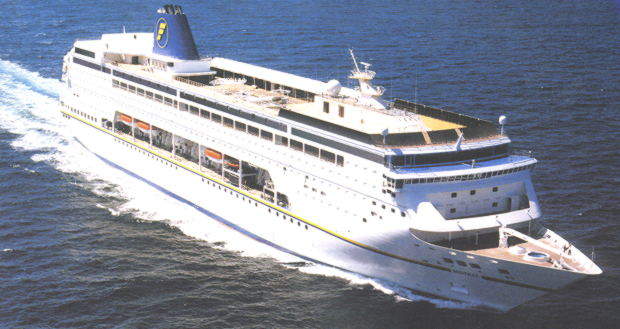The ship now known as Ambassador’s Ambition initially embarked on its nautical journey as MS Mistral. Built in 1999, it symbolised innovation within the cruise industry.
Over the decades, this vessel has evolved remarkably, transitioning through various guises and renovations while becoming emblematic of premium cruising experiences.
MS Mistral: The Ship’s Inception
In its nascent stage, the vessel known today as Ambition was christened MS Mistral, its original delivery date marked in a press release dated 10th November 1999. Initially, the ship wore the livery of Festival Cruises and was touted as their first new commission. Interestingly, despite its association with the French cruise industry, the company was based in Greece.
Designed explicitly for the European passenger market, MS Mistral was noted for being the largest French-flagged cruise ship since the iconic SS France of 1960. This noteworthy accolade, however, often overlooked the actual headquarters of Festival Cruises. After its inauguration, MS Mistral embarked on Mediterranean tours, subsequently commencing a series of cruises in the Caribbean during winter.
Powerplant and Engineering
Initially powered by a state-of-the-art diesel-electric propulsion system, MS Mistral boasted a quartet of Wärtsilä 38-series genset engines. These powerhouses were capable of spinning alternators at 600rpm, enabling a robust cruising speed of 19.5 knots and a maximum thrust at 21.5 knots.
Despite its technical savvy, the ship remained committed to passenger comfort. Stability was assured by Mitsubishi fin stabilisers, and noise levels minimised with other advanced features. Such pioneering technology underscores the significant engineering prowess behind the vessel’s initial build.
Cabins and Passenger Experience
MS Mistral originally offered a passenger capacity of 1,196 in twin cabins. The design, considered vibrant by 1990s standards, might seem excessive today, featuring a riot of colours that strongly appealed to guests accustomed to such aesthetics.
The cabins were equipped with an interactive television and information system, a notable advancement for its time. This system facilitated passenger engagement, providing information in multiple languages, and included updates on essentials like the on-board currency, which had transitioned to the newly established Euro.
Decks were named after cities across Europe, offering thematic intrigue and novelty for passengers. Public areas were thoughtfully located across decks five, six, and eleven, with certain features being nostalgically referenced today due to their vintage appeal.
Dining and Amenities
Original dining venues on MS Mistral included the main restaurant, L’Etoile, and the Rialto restaurant, which featured alfresco dining capabilities during the summer months. A standout feature was the marble centrepiece in the lobby, which included a waterfall element.
The Cannes deck, home to the ship’s sports club, included a leisure area with a pool and thalassotherapy facilities. The design of these spaces was then deemed luxurious with a focus on passenger comfort, showcasing the ship’s intent to cater to diverse recreational needs.
Entertainment and Recreational Facilities
MS Mistral offered extensive recreational facilities that included a theatre, sports club, and a discotheque, providing ample entertainment options for both adults and teenagers. The addition of card and cigar rooms further underscored the vessel’s aspiration to offer something for everyone.
The spa, a highlight of the Mistral at its inception, was one of the largest afloat during its launch, indicating a strong emphasis on wellness even in the early days. This dedication to wellness and leisure helped set the standard for future enhancements.
Navigate through Change
As we reflect on the vessel’s transformation from MS Mistral to the sophisticated Ambition, it’s clear that adaptation has been a constant. The changes implemented over the years were driven by both nostalgic reverence for its history and a commitment to modernisation.
Examining the initial press releases and archival materials, one can trace a narrative of evolution alongside the broader developments in the cruise industry. The ongoing enhancements reflect a desire to stay relevant and cater to modern consumer expectations, ensuring that the vessel not only survives but thrives.
Conclusion
In retrospect, the journey of Ambassador’s Ambition from MS Mistral represents a remarkable voyage of transformation. These changes underscore a deep-seated commitment to passenger satisfaction, melding tradition with innovation with each phase of its evolution.
The transformation from MS Mistral to Ambassador’s Ambition stands as a testament to visionary nautical redesign, exemplifying progress in maritime engineering and design. Such evolution highlights the perennial dance between maintaining tradition and embracing modernity, ensuring that the vessel continues to be a cherished enigma within the cruising world.

